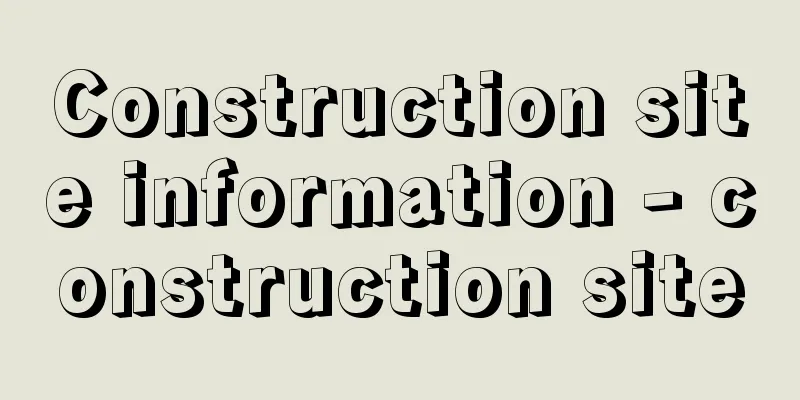Paris - Paris (English spelling)

OverviewThe capital of France. Located in the center of the Paris Basin in the north of the country, the Seine River runs through the city. Population: 2,125,246, metropolitan population: 9,644,507 (1999). Paris developed as the central city in every aspect of the country, which was one of the first European countries to unify, and even today, all activities in politics, economy, industry, culture, science, art, etc. are concentrated in Paris to an extent not seen in other countries, making it the most typical "capital" of the world's major cities. This characteristic, which has remained unchanged throughout its history, is clearly reflected in the current urban structure and general civic life, and this is where the charm of Paris lies. The Seine River, which flows through the city in an arc and adds a deep emotional atmosphere to its landscape, was the driving force behind the birth and development of Paris through its water transportation, and it still fulfills this role today (annual cargo handling volume at the Port of Paris, 21.3 million tons, 1994), while at the same time providing a space of relaxation for the suffocating residents of the big city. [Tatsutaro Hidaka] NatureParis is located at 48 degrees 50 minutes north and 2 degrees 20 minutes east, about 200 kilometers north of the center of the country's roughly hexagonal land. However, the presence of the Seine River and its tributaries near Paris created a fertile Paris Basin, giving Paris favorable conditions for controlling the basin using the rivers as a communication route. This allowed Paris to exclude other cities and become the capital since ancient times. The elevation of the Seine River in the city center is only 26 meters, but there are five hills around 100 meters high. The main communication route from the north to the south of the Paris Basin passed through the "pass" between Montmartre and Chaumont Hill, crossed the valley using the Île de la Cité, an island in the Seine River, as a stepping stone, and on the south side went up the Bièvre Valley between Sainte-Geneviève Hill and Montparnasse to emerge on a wide plateau. The Oise River, the Marne River and other tributaries of the Seine served as routes to connect the eastern and northern regions. This natural crossroads played a major role in the economic development of Paris and the spread of its political influence throughout the country. The surrounding hills provided stone, plaster and other building materials for the construction of the city. Although it is close to the 50th parallel, the climate is not harsh because it is in a basin that opens to the west and is influenced by the Atlantic Ocean and the English Channel. The average temperature is 3.4°C in January and 19.1°C in July, with an average annual precipitation of 641 mm and 171 rainy days. It belongs to the marine temperate climate, with unstable weather especially in spring. [Tatsutaro Hidaka] cityIn the mid-19th century, the central part of Paris, which corresponds to the present-day 1st to 10th arrondissements, was only about 25 square kilometers. Then, outside of that, the 11th to 20th arrondissements, districts mainly focused on handicrafts, developed, and with the Industrial Revolution, the industrial zone extended downstream along the Seine for convenient transportation, while spreading radially along the railways. Meanwhile, in the mid-19th century, residential areas with small gardens appeared as forests were cleared in the areas surrounding Paris for housing development, and after World War I, large-scale housing development extended into cultivated land. After World War II, the development of freight transport by truck and the spread of private automobiles meant that there was considerable freedom in the selection of sites for the construction of factories and new towns, and some of the remaining green spaces in the suburbs were also urbanized. Thus, in the space of about a century, the metropolitan area centered on Paris expanded to cover the entire Île-de-France (area of 12,012 square kilometers), including the three departments of Seine-Saint-Denis, Val-de-Marne, and Hauts-de-Seine that belong to the Petite Couronne (or Couronne Urbaine), and the four departments of Val-d'Oise, Seine-et-Marne, Yvelines, and Essonne that belong to the Grande Couronne (or Couronne Suburbaine), and the population expanded from just over 2 million to about 10 million. This means that 18.5% of the total population of France is concentrated in an area that is 2% of the country's land area. The population increase over this century was about 15 times in the suburban areas, but only about 50% in the Paris metropolitan area. The administrative city of Paris (within the 20 arrondissements) still remains within the ring roads that were built on the remains of the city walls from 1840. It stretches 12 km from east to west and 9 km from north to south, and includes the 846 hectares of the Bois de Boulogne to the west and the 995 hectares of the Bois de Vincennes to the east, giving it an area of about 105 square kilometers, making it a small city for the capital of a large country. This small city of Paris forms a special city as the seat of government, and at the same time forms the Paris prefecture, with the city council chaired by the mayor also administering the prefecture, but in recent years it has been gradually moving closer to the administrative form of a general city. The central part of Paris, known worldwide as the "City of Flowers," was founded on the construction of the capital by the kings in the 16th and 17th centuries. However, its current appearance is the result of modernization through numerous renovations and construction works, starting with the bold urban planning of Governor Haussmann in the mid-19th century and continuing through the early 20th century, including the demolition of areas densely populated with dilapidated houses and the relocation of residents to the outer edges of the city, and the construction of thoroughfares. Most of Paris' historical architecture is concentrated in this core area, which consists of the 1st to 6th arrondissements, and the city's functions are also divided into the commercial, financial, and crafts area on the right bank of the Seine and the educational and cultural area on the left bank, reflecting traditions dating back to the Middle Ages. To the west of this lies the bourgeois district, with 12 boulevards emanating from the Arc de Triomphe as its backbone, and the 16th arrondissement, which borders the Bois de Boulogne, has developed into an upscale residential area. On the east side and on both the north and south sides, there are many mid-class or lower houses, small factories, and warehouses, and in recent years, large-scale renovation work has been carried out in dilapidated and unsanitary areas, resulting in the appearance of high-rise buildings that are unusual for Paris in many places, such as the Maine-Montparnasse district and the 15th arrondissement on the left bank of the Seine. [Tatsutaro Hidaka] trafficThe city has 1,750 km of drinking water, 1,610 km of non-potable water, and 2,200 km of well-known sewage systems. There are 5,959 roads totaling 1,901 km. There are also over 15 km of motorways along the Seine River, and 35 km of expressways that completely encircle the city, but the city is facing an increase in automobile traffic and pollution. Of these, 331 km of sidewalks are lined with 100,000 trees, 7,032 benches, and various parks and green spaces totaling 2,214 hectares, which is 25% of the city's total area. Public transport has become increasingly important today. The Paris Municipal Transport Authority's underground (commonly known as the Metro) has 15 lines, a total length of 202 km, and transports 4.56 million people per weekday. The Paris Municipal Transport Authority's bus network operates 55 lines, covering a total length of 510 km, providing transportation for over 332 million people per year. In addition, there are 14,900 taxis (8,600 privately operated) that can use the bus lanes, and are distributed among 468 designated parking lots, making an average of 330,000 trips per day (most of the figures are from 1994 or 1995). For suburban residents commuting to the city, following the highways, the RER (Regional Express) network, which links suburban trains and the subway, has been developed, handling 1.4 million passengers per weekday, an average of 11 kilometers per day. The national railway network, which also played a role in strengthening centralization, is connected to the Paris-centered national railway network at six terminal stations by direction, with an average of 628 trains per day and a total of 88.2 million passengers per year. In addition to these six shared stations, there are three dedicated stations, and suburban lines (28 lines, 1,285 kilometers long) connect within a 50-kilometer radius of Paris. The number of trains is 5,100 per day, with an annual passenger load of over 540 million (all figures for 1994). Paris is connected to the rest of Europe as well as to other regions of the country by 20 national highways and four expressways running north, south, east and west. The southern expressway not only transports tourists to the Côte d'Azur, but also transports most of the fresh food from the south of France that the capital needs. 60% of all food products bound for Paris are transported by truck from the rest of the country. The northern and eastern expressways are routes for industrial products imported from Belgium and Germany. There are two international airports by air: Roissy (Charles de Gaulle), 25 km northeast of the city center, and Orly, about 15 km south. Charles de Gaulle handles 43.44 million passengers and 980,000 tons of cargo annually (1999). There are also several smaller airports within the capital for private aircraft and test flights. [Tatsutaro Hidaka] industryTraditional "products of Paris" since the Middle Ages include jewellery, precious metal work, musical instruments, luxury furniture, perfumes, and luxury clothing, as well as precision instruments, publishing, the music industry, and film. These industries are closely linked to Parisian human activities such as commerce, literary activities, and tourism, and have long been concentrated in the city or near its outskirts. Classic examples still remain today, such as precious metal work in the Marais and Temple districts, furniture in the Saint-Antoine district, and publishing in the Latin Quarter on the Left Bank. Meanwhile, the capital region as a whole forms the largest and most diverse industrial region in the country, housing 25% of the country's economically active population. This is largely due to the city's natural location, as well as the city's preferential conditions as the capital of a centralized state, such as population, capital concentration, and administrative functions. The driving forces behind the development of Paris' industrial area have been the chemical industry, which has made use of research and capital since the 18th century, the iron industry, which was brought about by the construction of railways starting from Paris and the development of steel-framed buildings from the mid-19th century onwards, and, since the early 20th century, cutting-edge industries such as electricity, automobiles, and aerospace have been added to this. In Paris, small factories are gradually being converted into housing or offices, and "deindustrialization" is proceeding slowly, while construction of suburban industrial zones in the east and north is still underway. These industrial zones differ from the traditional stone walls, chimneys, and worker housing in that they feature rows of functional, bright factories surrounded by lawns and large parking lots, where employees live in a somewhat secluded, quiet environment. The locations and landscapes of these industrial zones reflect changes in social conditions, such as the development of technology, transportation, and communication networks, and rising standards of living. In terms of the tertiary industry sector, Paris is also the largest industrial city in the country. The government and public institutions absorb 20% of the active population of the metropolitan area. In addition, the presence of over 400 international organizations, including the UNESCO headquarters, makes Paris worthy of the name of an international city. The communication and press, publishing, theater, arts, tourism and other sectors are thriving, and the tertiary industry is further supported by the headquarters of banks and insurance companies, as well as the headquarters and research departments of major corporations. [Tatsutaro Hidaka] Cultural FacilitiesFrance's intellectual activity and cultural treasures are also concentrated in Paris. The University of Paris (Paris I to Paris XIII) and its four great schools (Ecole Polytechnique, École Normale Supérieure, École Nationale d'Administration, and École Centrale) have a total of about 300,000 students, more than a third of whom are from the region or abroad. The majority of the major research institutions are located in Paris and its suburbs, and the city has 64 municipal libraries, 134 museums and art galleries, and 141 theatres. Paris, which attracts many tourists, is rich in historical architecture. The main ones are as follows. The Gothic Notre Dame Cathedral (12th-13th century) stands on the Île de la Cité, the birthplace of Paris, and is a symbol of Paris along with the Louvre Palace (now the Louvre Museum, 16th-19th century). The Invalides (Hôtel des Invalides) is a perfect example of the 17th century classical style, and was built by order of Louis XIV. The City Hall, located on the right bank of the Seine near Notre Dame Cathedral, is a palace building imitating the 19th century Renaissance style. The Neo-Baroque Opera House also dates from the same period. In contrast to these, the Eiffel Tower (1889), built for the Universal Exposition commemorating the 100th anniversary of the Revolution, and the Sacré-Coeur Cathedral (1876-1919), shining white atop Montmartre Hill, are buildings that symbolize modern Paris. [Tatsutaro Hidaka] World Heritage RegistrationThe banks of the Seine, lined with various historical buildings, were registered as a World Heritage Site by UNESCO (United Nations Educational, Scientific and Cultural Organization) in 1991 as "Banks of the Seine in Paris" (World Cultural Heritage). [Editorial Department] historyFrom ancient times to the Middle AgesThere are traces of life in the Paris Basin dating back to the Paleolithic period, but the direct origin of the city dates back to the 3rd century BC, when the Celtic Parisii settled on what would later become the Île de la Cité. The name Paris is derived from this. They first made a living from fishing, but soon began commercial activities along the Seine. The area was called Lutetia by the Romans, and came under the control of the Roman Empire when Caesar conquered Gaul in the 50s BC. The Roman city of Lutetia developed mainly on the left bank of the Seine during the 3rd century AD, and a water merchants' guild had already been formed. Even today, traces of that time remain in the remains of the amphitheater and the baths in Cluny Abbey (now the Cluny Museum). It was in the middle of the 3rd century that Saint Denis preached as the first bishop and left behind the story of his martyrdom. In the 4th century, invasions by Germanic peoples, especially the Franks, became more intense, and Julian, who was sent from Rome to deal with them, settled here and was recommended as emperor in 360. Population continued to grow around the Île de la Cité, and the first city walls were built at the beginning of the 5th century, but this marked the effective end of Roman rule. In the middle of the 5th century, Paris was once again under threat when it was attacked by the Huns led by Attila, but Saint Genevieve, who repelled the attack, was later venerated as the patron saint of Paris. From the beginning of the 6th century, Clovis made it the capital of the Merovingian dynasty, and the town expanded not only to the left bank but also to the right bank, centering on commerce, and it also became important in religious matters, as seen in the construction of monasteries. The famous Saint-Germain-des-Prés Abbey also originated in this period. However, from the end of the Merovingian dynasty to the Carolingian dynasty, it was removed from the political center, and Charlemagne made Aachen (now Germany) its capital. Then, in the second half of the 9th century, the Normans, the so-called Vikings, invaded from the mouth of the Seine, dealing a devastating blow to the outskirts of the city, which had existed since the Gallo-Roman period. [Fukui Norihiko] As a medieval cityParis's final success in fending off the Normans increased its prestige, and by the time Eude, Count of Paris, became King of the Franks in 888 and his descendant Hugh Capet founded the Capetian dynasty in 987, Paris' position as the centre of the kingdom was firmly established. From the time of Louis VI of the Capetian dynasty in the first half of the 12th century, Paris showed a leap in economy against the backdrop of the development of agricultural production in the surrounding area. The market, which began to develop in the current town hall square on the right bank, was later moved to the site of Les Halles (central market), which would later be called the "stomach of Paris", and in the early 13th century under Philip II, it became a full-fledged trading center. Philip II, who was called the Auguste (Auguste), who fought against the King of England to expand the territory of the Kingdom of France, suppressed the feudal lords and strengthened the power of the king, built city walls around Paris, paved the streets with stones, and had bridges built over the Seine. In the Middle Ages, bridges were made of wood, with houses built on them, and although they were sometimes destroyed by fire, the left and right banks were connected with the Île de la Cité in the middle, and the city began to develop. He also built the Louvre Palace on the right bank alongside the Royal Palace on the Île de la Cité, and granted privileges to merchant guilds, revitalizing the economy. On the left bank, the foundations of the University of Paris were built up on the Sainte-Geneviève hill, and by the end of the Middle Ages it had become the headquarters of scholasticism, attracting scholars from all over the world. This marked the establishment of the so-called Latin Quarter as an intellectual and cultural center. Construction of Notre Dame Cathedral as the seat of the Paris bishopric had already begun in the mid-12th century, and the grandeur of Gothic architecture came to symbolize the city's status as a religious center. Thus, Paris took on the appearance of a medieval city, and in the 13th century under Saint King Louis IX, the High Court and the Court of Accounts were established in the city, and coupled with the development of commerce, the population is said to have exceeded 100,000. The merchants, who had gained power, were granted autonomy as a city by the king, and a representative called a Prévost was appointed as mayor. In 1302, King Philip IV, who was in conflict with the Pope, called for support from citizen representatives as well as from monks and nobles, and held the first Three Estates General in Paris. This signified the financial strength of the citizens, but it also meant that Paris would suffer from heavy taxes imposed by the king from then on. In addition to economic difficulties such as the devastation of surrounding rural areas due to the Hundred Years' War at the end of the Middle Ages, food shortages, soaring prices, and heavy taxes, there was also the fear of mass deaths due to the plague. In 1358, a large-scale rebellion broke out in Paris under the command of Mayor E. Marcel, who called for political reform, but Charles V, known as the wise king, suppressed the rebellion and peace returned for a time. He expanded the city walls on the right bank to accommodate the development of commerce and industry, and had a clock tower built in the royal palace on the Île de la Cité, a symbol of order and innovation. However, after the death of Charles V, chaos returned, and the population, which was said to be 200,000 at the beginning of the 14th century, had halved by the end of the same century. Moreover, among the nobles who were divided into the Armagnac faction and the Burgundian faction and fighting throughout the country, in the early 15th century, Paris was temporarily dominated by the Burgundian faction, which had connections with the English army, and fell into extreme ruin and chaos, to the point where wolves were said to have appeared even within the city. [Fukui Norihiko] The Ancien RégimeFrancis I, who was intent on strengthening the royal power, established his base in Paris in 1528. New Renaissance-style buildings were constructed in the city, and the winds of humanism spread to Paris. In 1530, a royal professorship was established under the leadership of G. Budé, which became the forerunner of the Collège de France that still exists today. Commerce flourished and the population increased again. However, at the same time, many lower classes also flowed into the city, and in the maze of narrow alleys, a mysterious other world like the one François Billon sang about in his poems began to cling to the lower classes of the capital. From then on, the problem of the accumulating lower classes would remain serious for Paris. For about 30 years at the end of the 16th century, the religious wars once again plunged the capital into chaos, and under the control of Catholic forces, the St. Bartholomew's Day Massacre occurred in 1572. Under the rule of Henry IV, who put an end to this religious conflict, the city gradually began to develop and transform into a modern city. Place des Beauges (then Place Royal) and Place de Dauphine, which still look beautiful today, are the products of this. He completed the construction of the Pont Neuf (new bridge), built sidewalks, and focused on road management, waste disposal, and policies for the water supply, which was the lifeline of urban life. Paris once again clashed with the monarchy during the Fronde in 1648, but land readjustment and redevelopment continued under Prime Minister Richelieu during the reign of Louis XIII, and from the late 17th century under the reign of Louis XIV, with the western blocks, where the aristocracy and other upper classes lived, being particularly developed. Louis XIV himself did not like rebellious Paris, and moved to Versailles in 1677, making it the seat of government in 1682. However, Paris became famous throughout Europe as a city of commerce, religion, culture, and literature. The port of the Seine, which received goods for the city with a population of about 500,000, was bustling. In the 18th century, when philosophers and writers gathered in the salons of the Enlightenment, the city expanded further westward, and the prototypes of today's Place de la Concorde and the Champs-Élysées were also created during this period. In order to improve the functionality of the expanding city, attention was given to land reorganization, street lighting, health and sanitation, and the police system was also modeled on those of other European countries. However, these attempts at urban development were unable to keep up with the influx of people and the mounting problems, and issues of public health and poverty remained unresolved. The general crisis of the Ancien Régime led to the French Revolution. [Fukui Norihiko] From the Revolution to the PresentDuring the Great Revolution, which began with the storming of the Bastille in 1789 and saw the active involvement of Parisians and the sans-culottes, Paris once again became the capital. The population, estimated at 650,000 to 700,000 just before the revolution, soon rose to 1.05 million in 1846, 1.7 million in 1861 after the merger of surrounding towns and villages, and over 2.7 million in 1901. Most of this increase was due to the working class, but urban development could not keep up with the rapid population growth, and there was a large gap between the wealthy bourgeois districts in the west and the lower-class working-class districts that were prevalent in the north and east. In particular, in the first half of the 19th century, the working class was feared by the ruling class as a "dangerous class," and in fact began to become the center of the labor movement and socialist movement from the 1830s. In the 19th century, Paris became a turbulent capital, shaken by social movements that shook the politics of France and even Europe as a whole, including the July Revolution of 1830, the February Revolution and the June Affair of 1848, and the Paris Commune of 1871. Paris took on its present-day form with the urban remodeling known as "Haussmannization" that began under the Second Empire. The surrounding towns and villages were merged to form the current area, and the system of dividing the whole city into 20 administrative districts and each district into 4 quartiers (districts) began in 1860. Under the imperial government's strong power, wide boulevards ran through the old districts, and the complex alleys and old buildings were cleared from the center, and new buildings in the Second Empire style were built. The construction of the sewer system, famous for Hugo's Les Miserables, also began in earnest. Although the remodeling was temporarily interrupted by the Commune Uprising, it continued under the Third Republic, and Paris basically took on its modern form. At the end of the 19th century, the transformation accelerated with the industrial civilization represented by iron and electricity, such as the Eiffel Tower and the subway. Buses also appeared from 1905. During this period of industrialization, the city also became the center of the labor movement, which rose to the height of revolutionary syndicalism. Paris, which began to develop as a metropolitan area in the 20th century, has not only continued to be a major political stage with events such as the two world wars, the Popular Front, and the May Revolution of 1968, but it has also been a city of art, attracting avant-garde artists from all over the world, as famous for Surrealism, and attracting literary figures. Although the trend towards multipolarization to all parts of the world is clear, Paris remains the center of fashion and the epicenter of new movements in academic research and contemporary thought. [Fukui Norihiko] "The Real Paris -- Paris sans ford" by Tatsutaro Hidaka (1973, Zautou Publishing Association)" ▽ "Paris Hospitals -- 1794-1848" by E.H. Ackerknecht, translated by Yukio Tateno (1978, Shisosha)" ▽ "Holy Monday in Paris -- Behind the Scenes of Urban Turmoil in the 19th Century" by Akira Kiyan (1982, Heibonsha)" ▽ "The Great Reform of Paris -- Haussmann's Achievements" by H. Sahlman, translated by Akira Ozawa (1983, Inoue Shoin, The Cities = New Illustrated Series)" ▽ "The Backstreets of Paris History" by Toshio Horii (1984, Hakusuisha)" ▽ "Illustrated Paris History Story + Small Dictionary of Paris History Vol. 1" by Michel Dancell, edited and translated by Fumiya Kuramochi (1991, Hara Shobo)" ▽ "The Revolutionary 19th Century: A Collection of Paris City Maps," edited by the Cartographical Reference Compilation Committee (1995, Kashiwa Shobo)" ▽ "The Greater Paris Area: Its Structural Change," edited by Takahashi Nobuo, Tezuka Akira, and Jean-Robert Pitt (1998, Toyo Shorin)" ▽ "Paris Poverty and the Poetics of the Streets: Foreign Artists of the 1930s," written by Imabashi Eiko (1998, Toshi Shuppan)" ▽ "Paris: All Occupations: A History of the Life of the Common People from the Middle Ages to the Modern Era," new edition, edited by Paul Lorentz, written by F. Klein-Lebourg, and translated by Kitazawa Maki (1998, Ronsosha)" ▽ "Customs of Paris by Occupation," written by Kashima Shigeru (1999, Hakusuisha)" ▽ "Historical Maps of Paris," edited by Jean-Robert Pitt, supervised and translated by Kimura Shozaburo (2000, Tokyo Shoseki)" ▽ "Encyclopedia of the History of Paris" by Alfred Fierro, supervised and translated by Kashima Shigeru (2000, Hakusuisha) " ▽ "The History of Urban Planning of Paris" by Pierre Lavedan, translated by Doi Yoshitake (2002, Chuokoron-Bijutsu Shuppan)" ▽ "A History of Life in Medieval Paris" by Simone Roux, supervised by Sugisaki Taiichiro, translated by Yoshida Harumi (2004, Hara Shobo) " ▽ "The History of Paris" by M. Laval, translated by Kobayashi Yoshihiko and Yamaji Akira (Hakusuisha, Quessais-jes paperback)" ▽ "The History of Paris" by Yvan Combault, translated by Kobayashi Shigeru, new edition (Hakusuisha, Quessais-jes paperback)" ▽ "Paris in the 1930s" by R. de Belval, edited and translated by Yajima Midori (Iwanami Shinsho)" ▽ "Paris: Travel Trivia Notes" by Tamamura Toyoo (Shincho Bunko)" ▽ "The History of the Customs and Customs of Paris" by Andre Varnot, translated by Kitazawa Maki (Kodansha Academic Library) [References] | | | | | | |Oise River| |Capete | | | | |Abbey of | |St | | | | | | | | | | Paris| | | | | | | | | | | | | | |Fronde| | | | | | | | | | | | |A representative river in France that runs through the center of Paris. The riverbank is a popular strolling spot for locals and tourists. The photo shows the right bank of the Seine, near the Louvre Museum. France, Paris ©Shogakukan "> The Seine Place Royale (King's Square) was built by King Henri IV. It was completed in 1612 and renamed to its current name in 1800. It is located in the Marais district (4th arrondissement), east of the Paris City Hall. France, Paris ©Masashi Tanaka "> Place des Vosges A stone bridge connecting the Île de la Cité and both banks of the Seine. Completed in 1604, it is the oldest bridge in Paris. On the right of the photo is the dock of the Île de la Cité, and in the background you can see the townscape on the left bank of the Seine. Part of the World Heritage Site "Banks of the Seine in Paris" (registered in France in 1991) Paris, France ©Masashi Tanaka "> Pont Neuf A victory monument standing in Place Charles de Gaulle. It was designed by French architect Chalgrin at the command of Napoleon in 1806 and completed in 1836. It is 50m high, 45m wide, and 22m deep. The tomb of the Unknown Soldier is placed directly under the great arch. France Paris ©Shogakukan "> Arc de Triomphe A 1,880m-long boulevard stretching from Place de la Concorde to Place Charles de Gaulle. Known to people all over the world as the heart of Paris. It is a bustling shopping district lined with many famous shops, restaurants, theaters, and more. Paris, France ©Masashi Tanaka "> Champs-Élysées Built in the 18th century, its name changed over time. It is known as the site where many famous men, including Louis XVI and Mari Antoinette, were executed. In the center of the square is an obelisk, which was moved from Luxor, Egypt in 1836. Part of the World Cultural Heritage Site "The Seine River in Paris" (registered in 1991) France Paris © Shogakukan "> Place de la Concorde The oldest university in France. It originated from the Sorbonne, which was established by the monk Sorbonne in the 13th century. It developed into one of the most prestigious universities in Europe, but was dissolved in 1968 due to an increase in the number of students, and reorganized into 13 new universities. Paris I to Paris IX are located in the city of Paris. The photo shows the main gate of the University III and University IV campuses in the Latin Quarter. Paris, France ©Masashi Tanaka "> University of Paris (Sorbonne) A typical early French Gothic building. The photo shows the west front. It features two bell towers over 60m tall, with a rose window of 9.6m in diameter attached to the center. Under the rose window are 28 statues of the Old Testament kings. Part of the World Cultural Heritage Site "The Seine River in Paris" (registered in 1991) France Paris ©Masashi Tanaka "> Notre Dame Cathedral (Paris) Louvre Palace is viewed from the Tuileries Gardens. In 1793, most of the palace became a museum with royal collections, and the entire palace is now a museum. Part of the World Cultural Heritage Site "The Seine River in Paris" (registered in 1991) France Paris © Fujino Yuya "> Louvre Palace (Louvre Museum) Originating from the Royal Academy of Music of France, founded in 1669, this is France's leading opera house. The current building was designed by architect Charles Garnier and completed in 1875. It is also called the Palais Garnier (Opera Garnier). France, Paris ©Masashi Tanaka "> Paris Opera Built for the 1889 Paris World's Fair, it was the tallest steel tower in the world at the time. It is said that 7,300 tons of wrought iron were used in its construction. It is 324 meters tall. Part of the World Heritage Site "Banks of the Seine in Paris" (France, registered in 1991) France, Paris ©Shogakukan "> Eiffel Tower A symbolic building in Paris, located on the hills of Montmartre. The dome is 83m tall. Construction began in 1876, designed by architect Paul Abadi, and completed in 1910 (the dedication ceremony was held in 1919). France Paris ©Shogakukan "> Sacre Coeur Cathedral A temple on Sainte-Geneviève Hill in the Latin Quarter. It was originally a monastery church dedicated to Sainte-Geneviève, the patron saint of Paris, but was remodeled in the 18th century to become the Pantheon. It was designed by Soufflot, a leading French neoclassical architect. Paris, France ©Masashi Tanaka "> Pantheon (Paris) A classical church building completed in 1842. It has a Greek temple-like exterior surrounded by Corinthian colonnades, and the gable is decorated with Lemaire's sculpture, The Last Judgment. It is 30m tall, 43m wide, 108m deep. It is known as "La Madeleine." Part of the World Cultural Heritage Site "The Seine Rivers of Paris" (registered in 1991) France Paris ©Masashi Tanaka "> Cathedral of Sainte Madeleine The National Museum of Art opened in 1986. It is a remodeled station building at the former National Railway Orsay station, and houses and exhibits paintings, sculptures, crafts, photographs, and more from 1848 to 1914. You can view Impressionist works such as Courbet, Manet, Monet, and Renoir, as well as works by Cezanne, Gauguin, Van Gogh. Part of the World Cultural Heritage Site "The Seine River in Paris" (registered in France, 1991) France Paris ©Masashi Tanaka "> Musee d'Orsay A museum known for displaying Monet's masterpiece, Water Lilies, from his later years. In addition to Monet, it also houses works by Cezanne, Renoir, Picasso, Rousseau, Matisse, Modigliani, Utrillo, Laurentan. Located in the Tuileries Gardens. France ©Shogakukan "> Orangerie Museum A dance hall located on Rue Clichy in Montmartre. Built in 1889, it gained popularity in French Cancan. It is known for its neon signs of the "red windmill" that decorates the night view, and is one of the world-famous tourist attractions in Paris. France ©Masashi Tanaka "> Moulin Rouge Source: Shogakukan Encyclopedia Nipponica About Encyclopedia Nipponica Information | Legend |
概説フランスの首都。同国北部、パリ盆地の中央部に位置し、セーヌ川が市内を貫流する。人口212万5246、首都圏人口964万4507(1999)。欧州諸国のうちでも統一の早かったこの国のあらゆる面における中心都市として発展し、現在なお政治、経済、工業そして文化、科学、芸術などすべての部門における活動は他国に例のみられないほどパリに集中しており、世界の大都会のなかでもっとも典型的な意味における「首都」である。その歴史の各時期を通じて変わることなく続いたこの特性は、現在の都市構成および市民生活一般のうちにも明らかに反映しており、パリの魅力もここにある。市街を弧状に貫流してその景観に深い情緒を添えているセーヌ川は、その水運を通じてパリの発生と発展の原動力となったが、現在なおこの役目を果たしながら(パリ河港の年間荷扱量2130万トン、1994)、一方では息詰まりがちな大都会の住人のために憩いの空間を提供している。 [日高達太郎] 自然パリは北緯48度50分、東経2度20分に位置し、ほぼ六角形の国土の中心からは約200キロメートルも北に偏っている。しかし、セーヌ川およびパリ付近でこれに合流する諸支流の存在が、肥沃(ひよく)なパリ盆地をもたらし、河川を連絡路として盆地を支配できるという好条件をパリに与えた。これによりパリは古くから他市を排して首都となることができた。市街中心部セーヌ河畔の標高は26メートルにすぎないが、周囲には100メートル前後の丘が五つある。パリ盆地の南北方向の主要連絡路は、モンマルトルとショーモンの丘の間の「峠」を通過し、セーヌ川の中の島シテ島を飛び石としてこの谷を渡り、南側ではサント・ジュヌビエーブの丘とモンパルナスの間のビエーブルの谷をさかのぼって広い台地の上に出るものであった。 オアーズ川、マルヌ川などのセーヌ支流は東方および北方の両地域との連絡路となった。この天然の十字路ともいうべき立地が、パリの経済的発展と政治的影響力の全国浸透に大きな役割を果たす。周囲の丘は、石材、漆食(しっくい)など建築材料を提供して都市建設に役だった。 気候条件も、北緯50度に近いにもかかわらず、西に向かって開いている盆地内にあって大西洋とイギリス海峡からの影響を受けるおかげでけっして厳しいものではない。平均気温は1月の3.4℃、7月の19.1℃、年降水量は641ミリメートル、降雨日数171日。とくに春に天候が不安定になる海洋性の温帯気候に属している。 [日高達太郎] 市街19世紀なかばのパリ市街は、現在の第1区から第10区までに相当する中心部、約25平方キロメートルにすぎなかった。ついでその外側に第11区から第20区までの手工業を主とする地区が発展、産業革命とともに、工業地帯が輸送に便利なセーヌ下流に向かって延びる一方、鉄道に沿って放射状に広がった。他方、19世紀なかばにはパリ周辺地区の森林を切り開く宅地造成により、小さな庭をもった郊外個人住宅地が現れ、第一次世界大戦後は大規模な宅地造成が耕作地にも及ぶ。第二次世界大戦を機に、トラックによる貨物輸送の発展、自家用自動車の普及などにより、工場、新都市の建設地選択はかなり自由となり、近郊に残っていた緑地の一部も都市化された。かくしてパリを中心とする都市圏の広がりは、約1世紀の間に、「小冠」Petite Couronne(または都市域冠Couronne Urbaine)に属するセーヌ・サン・ドニ、バル・ド・マルヌ、オー・ド・セーヌ3県と「大冠」Grande Couronne(または副都市域冠Couronne Suburbaine)に属するバル・ドアーズ、セーヌ・エ・マルヌ、イブリーヌ、エソンヌ4県を擁するイル・ド・フランス全域(面積1万2012平方キロメートル)におよび、人口は200万強から約1000万に膨張した。全国土の2%にあたる土地にフランス全人口の18.5%が集中していることになる。この約1世紀間の人口増加は、郊外地区では約15倍であるのに対し、パリ市域では約50%増にすぎない。 行政上のパリ市(20区内)は、現在も1840年の城壁跡の環状大通りの内側にとどまっている。その広がりは東西12キロメートル、南北9キロメートル、これに西側のブローニュの森846ヘクタールと東側のバンセンヌの森995ヘクタールが加わり、面積は約105平方キロメートル、大国の首都としては小さい都市である。この小さなパリ市は政府所在地として特別市を形成し、同時にパリ県をもなし、市長を議長とする市議会が県行政も行っているが、近年はしだいに一般の市の行政形態に近づく傾向がある。 いわゆる「花の都パリ」として世界に知られる中心部は、16、17世紀の国王による首都建設を基盤としている。しかし現在の姿は、まず19世紀中葉のオスマン知事による大胆な都市計画に始まって20世紀初頭まで、老朽家屋の密集地区の取り壊しとその住民の市域外縁への移転、大通りの貫通など、多くの改新、建設工事による近代化の結果である。パリの歴史的建築物の大部分は、第1区から第6区までを構成するこの核心部に集中しており、都市機能もセーヌ右岸の商業・金融・手工業地域と、左岸の教育・文化地域に分かれているなど、中世以来の伝統を反映している。この西側に、エトアール凱旋門(がいせんもん)を中心に発する12本の大通りを骨格としたいわばブルジョア地区があり、なかでもブローニュの森に接する第16区は高級住宅地として発展した。東側と南北両側には中級以下の住宅、小工場、倉庫などが多く、近年に至って老朽、非衛生的地区を対象とした大刷新工事が行われ、メーヌ・モンパルナス地区、第15区セーヌ左岸地区など、パリとしては異様ともいえる高層建築物が出現した所も少なくない。 [日高達太郎] 交通水道は、飲用水道延長1750キロメートル、非飲用水道1610キロメートル、有名な下水道2200キロメートルを備える。道路は5959本、その延長は1901キロメートル。ほかに、セーヌ河岸自動車専用道路15キロメートル余、市域を完全に取り巻く高速道路35キロメートルなどがあるが、市内自動車交通と公害の増大に直面している。うち331キロメートルの歩道上には計10万本の並木、7032のベンチ、市域総面積の25%にあたる2214ヘクタールに達する各種公園緑地を確保している。 公共交通機関の重要性が増大している今日、パリ市交通公団地下鉄(通称メトロ)は15路線、延長202キロメートル、週日には1日当り456万人を輸送している。同公団バスは、55路線の網目を張り、延長510キロメートルを連絡、年間3億3200万人余の足となっている。さらに、バス専用レーンも通れる1万4900台のタクシー(個人営業8600台)が、468の専用駐車場に分散して、1日平均33万回利用されている(以上の数値はほとんど1994年または95年)。 市内に通う郊外居住者のためには、高速道路による連絡に続いて、郊外電車と地下鉄を結び付けたRER(首都圏急行網)も発展、週日には1日当り140万人、1日当り平均11キロメートルに及ぶ移動を受けもっている。中央集権の強化にも役だったパリ中心の全国鉄道網とは、方角により六つのターミナル駅で結ばれ、列車本数は1日平均628、年間乗客数は計8820万人に達する。これら六つの共用駅のほか三つの専用駅をもち、パリを中心に50キロメートル圏内を結ぶ郊外線(28路線、延長1285キロメートル)が通じている。その列車本数は日に5100、年間利用者数は5億4000万余人である(以上1994年の数値)。 国内諸地方はもとよりヨーロッパ諸国とは、20本の幹線国道と東西南北に向かう4本の高速道路によって結ばれる。南の高速道路はコート・ダジュールへ観光客を導くのみならず、首都の胃袋が必要とする南フランスの生鮮食料の大部分を輸送している。パリ向け食料品全体の60%は、各地方からのトラック輸送によっている。北と東の高速道路はベルギー、ドイツから輸入される工業製品のルートである。空路では、市街中心から北東25キロメートルにロアシー(シャルル・ドゴール)、南約15キロメートルにオルリーの2国際空港がある。シャルル・ドゴール空港は年間に旅客4344万人、貨物98万トンを扱う(1999)。ほかに自家用機、試験飛行用の小空港も首都圏内にいくつかある。 [日高達太郎] 産業中世以来の伝統的「パリ製品」として宝石細工、貴金属細工、楽器、高級家具、香水、高級衣装などがあるほか、精密器具、出版物、音楽産業、映画などが広く知られている。これらの産業は、パリの商業、文芸活動、観光など、いわばパリ的人間活動に密接に結び付いているだけに、古くから市内あるいはその外縁近くに集中していた。現在なおマレ地区、タンプル地区の貴金属細工、サンタントアーヌ地区の調度品、左岸ラテン区(カルチエ・ラタン)の出版など、典型的な例も残っている。一方、首都圏全体は同国経済活動人口の25%を擁する最大かつ多様な工業地域を形成している。これも自然立地のほか、人口、資本の集中、行政機能など、中央集権国家の首都としての特恵的諸条件によるところが大きい。 パリ工業地帯発展の原動力としては、18世紀以来の研究と資本とを生かした化学工業、19世紀中葉以後のパリを起点とする鉄道建設、鉄骨建築の発展などに伴う鉄工業などがあり、さらに20世紀初頭以来の電気、自動車、航空機など、時代の先端を行く諸工業がこれに加わっている。 パリ市内では小工場がしだいに住宅あるいは事務所に転換され、「非工業化」が緩慢に行われている一方、現在も東と北側の遠郊工業地帯の建設が進んでいる。これらの工業地帯は、石塀と煙突に工員住宅という伝統的なものとは異なり、芝生と広い駐車場に囲まれた機能的で明るい工場が並んでおり、従業員は多少とも離れた静かな環境のうちに住んでいる。これら工業地帯の立地も景観も、技術、運輸手段、通信網の発展、生活水準の向上など、社会条件の変革の反映である。 第三次産業部門においても、パリは全国最大の産業都市である。政府と公共機関は、首都圏活動人口の20%を吸収している。また、ユネスコ本部をはじめ400を超える国際機関の存在は国際都市の名にふさわしい。通信・報道、出版、演劇、芸術、観光などの諸部門が発展しているし、さらには銀行、保険会社の本社、大企業の本部と研究部門の存在などが第三次産業を支えている。 [日高達太郎] 文化施設フランスの知的活動と文化財もパリに集中している。パリ第一~第十三大学までのパリ大学と4大学校(理工科大学〈エコール・ポリテクニク〉、高等師範学校〈エコール・ノルマル・シュペリュール〉、国立行政学校〈エコール・ナショナル・ダドミニストラシオン〉、工業専門学校〈エコール・サントラル〉)には計約30万に及ぶ学生が通い、その3分の1以上が地方あるいは外国出身である。主要な調査研究機関の大部分がパリ市内とその近郊にあり、市内には市立図書館64、博物館・美術館134、劇場141がある。 多くの観光客が訪れるパリには歴史的建造物が豊富である。その主要なものをあげれば以下のとおりである。ゴシック様式のノートル・ダム大聖堂(12~13世紀)は、パリ発祥の地シテ島に建ち、ルーブル宮殿(現ルーブル美術館、16~19世紀)とともにパリの象徴的存在である。アンバリッド(廃兵院)は17世紀古典様式の完成例で、ルイ14世の命により建築された。ノートル・ダム大聖堂に近いセーヌ右岸に建つ市庁舎は、19世紀ルネサンス様式を模した宮殿建築。ネオ・バロック様式のオペラ座も同時期のものである。これらに対して、大革命100年記念の万国博で建てられたエッフェル塔(1889)や、モンマルトルの丘の頂上に白く輝くサクレ・クール大聖堂(1876~1919)などは、近代パリを象徴する建築物となっている。 [日高達太郎] 世界遺産の登録さまざまな歴史的建造物が建ち並ぶセーヌ川河岸は1991年、ユネスコ(国連教育科学文化機関)により「パリのセーヌ河岸」として世界遺産の文化遺産に登録された(世界文化遺産)。 [編集部] 歴史古代から中世へパリ盆地には旧石器時代からの生活の跡が認められているが、都市としての直接の淵源(えんげん)は、紀元前3世紀ころケルト系のパリシイ人Parisiiが後のシテ島を中心に住み着いたことにある。パリの名もそれに由来する。初め漁労生活を営んでいた彼らは、じきにセーヌ川を使って商業活動にも入った。この地はローマ人によってルテチアLutetiaとよばれ、前50年代のカエサルによるガリア征服とともにローマ帝国支配下に置かれる。紀元後3世紀にかけて、おもにセーヌ川左岸を中心に発展したローマ都市ルテチアには、すでに水上商人組合がつくられていた。現在でも、円形闘技場跡や、クリュニー修道院(現、クリュニー美術館)内の浴場跡に、当時のおもかげが残されている。聖ドニが初代司教として布教し、殉教の逸話を残したのも3世紀なかばであった。 4世紀になるとゲルマン人、とりわけフランク人の侵入が激しくなり、その対応のためにローマから派遣されたユリアヌスはこの地に居を定め、360年に皇帝に推挙された。シテ島を中心に集住化が進み、5世紀初めには最初の市壁がつくられたが、ローマの支配は実質上終わりを告げてゆく。5世紀なかばにはアッティラの率いるフン人の襲来を受け、パリはふたたび脅威にさらされるが、その攻撃を退けた聖女ジュヌビエーブは、その後パリの守護聖人として崇(あが)められることになる。 6世紀初めからクロービスによってメロビング朝の首都とされ、商業を中心に左岸のみでなく右岸にも町が広がり、修道院の建立などもみて宗教的にも重要になっていった。有名なサン・ジェルマン・デ・プレ修道院もこの時代に起源をもつ。だがメロビング朝末期からカロリング朝時代には政治の中心から外され、カール大帝はアーヘン(現、ドイツ)を首都とした。そして9世紀後半にノルマン人、いわゆるバイキングがセーヌ河口からさかのぼって襲来し、ガリア・ローマ時代からの都市周辺部は壊滅的な打撃を被る。 [福井憲彦] 中世都市として最終的にノルマン人の攻撃を退けることができたパリは、その声望を高めた。888年パリ伯ユードがフランク国王となり、その子孫ユーグ・カペーが987年にカペー朝を始めるころには、王国の中心としての位置は揺るぎないものになりつつあった。 12世紀前半、カペー朝のルイ6世のころから、周辺の農業生産の発展を背景に経済的にも飛躍を示す。右岸にある現在の市庁舎前広場に発展しだした市場は、のちに「パリの胃袋」とよばれることになるレ・アル(中央市場)の場所に移され、フィリップ2世のもとで13世紀初めには本格的に取引の中心になった。イングランド王と争ってフランス王国の領土を拡張、封建諸侯を抑えて国王の権勢を強め、尊厳なる王(オーギュスト)とよばれたフィリップ2世は、パリの周囲を市壁で固め、街路に舗石(ほせき)を敷き、セーヌ川には橋を架けさせた。中世の橋は木造で、橋上には家屋がしつらえられており、ときには火災で焼失もしたが、シテ島を中央に左右両岸が連結して発展の途につく。彼はまたシテ島の王宮と並んで右岸にルーブル宮を建て、商人ギルドに特権を付与して経済の活性化を図った。左岸では、サント・ジュヌビエーブの丘にかけてパリ大学の基礎が築かれ、やがて中世末にはスコラ学の総本山として諸国から学者をひきつけることになる。知的・文化的中心としてのいわゆるカルチエ・ラタンの成立である。すでに12世紀なかばから、パリ司教座教会としてノートル・ダム大聖堂の建築が始まっており、ゴシック建築の偉容が宗教的中心の地位を象徴することになる。 こうして中世都市としての姿を整えていったパリには、13世紀の聖王ルイ9世のもとで高等法院と会計院が置かれ、さらに商業の発展と相まって人口も10万を超えたといわれる。力を蓄えた商人たちは都市としての自治権を王から認められ、プレボとよばれる代表を市長として選任するようになる。1302年、教皇と対立していた国王フィリップ4世は、僧侶(そうりょ)・貴族と並んで市民代表にも支援を求め、最初の三部会をパリに開いた。これは市民の財力の強さを意味するが、またこれ以後パリは国王の重税に苦しむことにもなる。中世末の百年戦争に伴う周辺農村の荒廃、食料不足と物価高騰、重税といった経済的困難に、ペスト流行による大量死の恐怖が加わった。 政治の改革を求めたパリは市長のE・マルセルの指揮下に1358年、大規模な反乱を起こすが、賢明なる王と称されたシャルル5世がこれを鎮圧し、いったん平穏が戻る。彼は右岸の市壁を広げて商工業の発展への対応を用意し、シテ島の王宮には秩序と革新の象徴ともいえる時計塔をつくらせた。 しかしシャルル5世死後また混迷が訪れ、14世紀初めに20万といわれた人口は、同世紀末には半減していた。しかもアルマニャック派とブルゴーニュ派に分裂して全国で争っていた貴族のうち、15世紀初めに一時パリはイギリス軍と通じるブルゴーニュ派に支配されて荒廃と混迷を極め、市内にすらオオカミが出没するほどだったといわれている。 [福井憲彦] アンシャン・レジーム期王権強化に腐心したフランソア1世は、1528年パリに本拠を定めた。市内にはルネサンス様式の建物が新築され、人文主義の風がパリにも及ぶ。G・ビュデを指導者として1530年、王立教授団が設置され、いまに続くコレージュ・ド・フランスの前身となり、商業も繁栄して人口はまた増加した。しかし同時に下層民も多く流入し、狭い路地が入り組む街区には、フランソア・ビヨンが詩に歌ったような怪しげな別世界が首都の下層に張り付く。これ以後パリにとって、堆積(たいせき)する下層民の問題は深刻なものであり続ける。 16世紀末の約30年間、宗教戦争はまたしても首都を混乱に陥れ、カトリック勢力の支配下に、1572年にはサン・バルテルミーの虐殺が起こった。この宗教対立を収拾したアンリ4世統治下から、近代都市への整備と脱皮が徐々に進みだす。現在も美しい姿をみせるボージュ広場(当時はロアイヤル広場)やドフィーヌ広場は、その産物である。彼は工事中のポン・ヌフ(新橋)を完成させ、歩道を設け、道路管理や塵芥(じんかい)処理、さらに都市生活の命綱である上水道のための政策にも力を入れた。1648年のフロンドの乱でまたしてもパリは王権と衝突するが、その前のルイ13世時代には宰相リシュリューの下で、そして17世紀後半からのルイ14世治下にも、区画整理や再開発は続行し、貴族など上流階層の住む西寄りの街区がとくに整備されていった。ルイ14世自身は反抗的なパリを好まず、1677年にはベルサイユに移り、1682年にそこを政府本拠としたが、パリは商業はもとより、宗教や文化・文芸の都として全ヨーロッパに名が響く。約50万の人口を抱える都市への物資受け入れ口であるセーヌ河港は、大いににぎわった。 啓蒙(けいもう)主義のサロンに哲学者や文人たちが集まった18世紀に、町はさらに西に広がり、現在のコンコルド広場やシャンゼリゼ大通りの原型もこの時代につくられた。膨張した都市の機能をよくするための区画整理、街頭照明、保健衛生などへの配慮が強まり、警察機構もヨーロッパ諸国のモデルにされた。 しかしこうした都市整備の試みも、流入する人口の多さや問題の山積に追い付かず、公衆衛生や貧民問題は解決されないまま、旧体制(アンシャン・レジーム)の全般的危機はフランス革命を惹起(じゃっき)した。 [福井憲彦] 大革命から現代へ1789年バスチーユ襲撃に始まり、パリ市民とサン・キュロットが活躍した大革命下に、パリはふたたび首都になった。革命直前に約65万から70万と推定される人口は、やがて1846年に約105万、周辺町村合併後の1861年に約170万、1901年には270万余と急増する。その増加は大部分が労働階層であったが、都市整備は人口急増に追い付かず、西の裕福なブルジョア地区と、北や東に多い下層労働者地区の落差は大きかった。とくに19世紀前半に労働階層は「危険な階層」として支配階層に恐れられ、実際1830年代からは労働運動や社会主義運動の中心にもなり始めた。19世紀のパリは、1830年の七月革命、1848年の二月革命と六月事件、1871年のパリ・コミューンをはじめ、フランス全体の政治やヨーロッパ全体をも震撼(しんかん)させる社会運動に揺れる激動の首都となる。 パリが現在のもとになる姿をとるのは、第二帝政下に開始された「オスマン化」とよばれる都市改造からである。周辺町村を合併して現在の面積になり、全体を20の行政区に、各区を4カルチエ(区)に分ける制度も1860年からである。帝政の強権下に幅の広い大通りが旧街区を貫き、入り組んだ路地や古い建物が中心部から一掃されて第二帝政様式といわれる建物が新築され、ユゴーの『レ・ミゼラブル』で有名な下水道の整備も本格化する。一時コミューン蜂起(ほうき)で中断されるが、第三共和政下にも改造は続行され、基本的に現代の姿をとったパリは、19世紀末にはエッフェル塔や地下鉄など鉄と電気に示される工業文明によって、その変化を加速する。1905年からは乗合自動車(バス)も登場した。この産業化開始の時期には、革命的サンジカリズムとして高揚した労働運動の中心地ともなった。 20世紀に入って首都圏として発展し始めたパリは、二度の世界大戦や人民戦線、1968年「五月革命」などのできごとで政治の檜(ひのき)舞台であり続けたばかりではなく、シュルレアリスムで有名なように世界各地から前衛的芸術家を集め、文学者をひきつける芸術の都でもあった。世界各地への多極化の動きは明確であるが、いまでもパリはファッションの中心であり、また学問研究や現代思想の新しい動きの震源地であり続けている。 [福井憲彦] 『日高達太郎著『素顔のパリ――Paris sans ford』(1973・座右宝刊行会)』▽『E・H・アッカークネヒト著、館野之男訳『パリ病院――1794~1848』(1978・思索社)』▽『喜安朗著『パリの聖月曜日――19世紀都市騒乱の舞台裏』(1982・平凡社)』▽『H・サールマン著、小沢明訳『パリ大改造――オースマンの業績』(1983・井上書院・The Cities = New Illustrated Series)』▽『堀井敏夫著『パリ史の裏通り』(1984・白水社)』▽『ミシェル・ダンセル著、蔵持不三也編訳『図説 パリ歴史物語+パリ歴史小事典 上』(1991・原書房)』▽『地図資料編纂会編『革命期19世紀――パリ市街地図集成』(1995・柏書房)』▽『高橋伸夫・手塚章、ジャン・ロベール・ピット編『パリ大都市圏――その構造変容』(1998・東洋書林)』▽『今橋映子著『パリ・貧困と街路の詩学――1930年代外国人芸術家たち』(1998・都市出版)』▽『ポール・ロレンツ監修、F・クライン・ルブール著、北沢真木訳『パリ職業づくし――中世から近代までの庶民生活誌』新装版(1998・論創社)』▽『鹿島茂著『職業別 パリ風俗』(1999・白水社)』▽『ジャン・ロベール・ピット編、木村尚三郎監訳『パリ歴史地図』(2000・東京書籍)』▽『アルフレッド・フィエロ著、鹿島茂監訳『パリ歴史事典』(2000・白水社)』▽『ピエール・ラヴダン著、土居義岳訳『パリ都市計画の歴史』(2002・中央公論美術出版)』▽『シモーヌ・ルー著、杉崎泰一郎監修、吉田春美訳『中世パリの生活史』(2004・原書房)』▽『M・ラヴァル著、小林善彦・山路昭訳『パリの歴史』(白水社・文庫クセジュ)』▽『イヴァン・コンボー著、小林茂訳『パリの歴史』新版(白水社・文庫クセジュ)』▽『R・ドゥ・ベルヴァル著、矢島翠編訳『パリ1930年代』(岩波新書)』▽『玉村豊男著『パリ 旅の雑学ノート』(新潮文庫)』▽『アンドレ・ヴァルノ著、北沢真木訳『パリ風俗史』(講談社学術文庫)』 [参照項目] | | | | | | | | | | | | | | | | | | | | | | | | | | | | | | | | | | | | | | | | | | | | | | | | | | | | | | | | | | |パリ中心部を貫流するフランスの代表的河川。河岸は市民や観光客のかっこうの散策地となっている。写真はセーヌ川右岸、ルーブル美術館付近。フランス パリ©Shogakukan"> セーヌ川 アンリ4世によって建設されたプラス・ロアイヤル(王の広場)。1612年に完成、1800年に現名称に改称された。パリ市庁舎の東、マレ地区(第4区)にある。フランス パリ©Masashi Tanaka"> ボージュ広場 シテ島とセーヌ川両岸を結ぶ石造の橋。1604年に完成したパリ最古の橋である。写真右はシテ島の船着き場、奥側にはセーヌ川左岸の町並みがみえる。世界文化遺産「パリのセーヌ河岸」の一部(フランス・1991年登録) フランス パリ©Masashi Tanaka"> ポン・ヌフ シャルル・ドゴール広場に建つ戦勝記念碑。1806年ナポレオンの命により、フランスの建築家シャルグランが設計、1836年に完成した。高さ50m、幅45m、奥行22m。大アーチの真下には、無名戦士の墓碑が安置されている。フランス パリ©Shogakukan"> エトアール凱旋門 コンコルド広場からシャルル・ドゴール広場に至る、長さ1880mの大通り。パリの中心街として世界中の人々に知られる。多くの有名店、レストラン、劇場などが建ち並ぶ繁華街となっている。フランス パリ©Masashi Tanaka"> シャンゼリゼ大通り 18世紀なかばに建設され、歴史とともにその名称を変えてきた大広場。ルイ16世、マリ・アントアネットをはじめ多くの名士の処刑が行われた場所として知られる。広場中央には、1836年エジプトのルクソールから移されたオベリスクが立つ。世界文化遺産「パリのセーヌ河岸」の一部(フランス・1991年登録) フランス パリ©Shogakukan"> コンコルド広場 フランス最古の大学。13世紀に僧侶ソルボンが開設したソルボンヌ学舎を起源とする。ヨーロッパ屈指の名門大学として発展したが、学生数の増加に伴って1968年に解体され、13の新制大学に再編された。パリ市内にはパリ第一~第九大学がある。写真はカルチエ・ラタンにある第三・第四大学キャンパスの正門。フランス パリ©Masashi Tanaka"> パリ大学(ソルボンヌ) 初期フランス・ゴシック様式の代表的建築物。写真は西正面。高さ60mを超える二つの鐘塔を配し、中央には直径9.6mのバラ窓が取り付けられている。バラ窓の下には28体の『旧約聖書』の王たちの彫像が並ぶ。世界文化遺産「パリのセーヌ河岸」の一部(フランス・1991年登録) フランス パリ©Masashi Tanaka"> ノートル・ダム大聖堂(パリ) チュイルリー庭園から望むルーブル宮殿。1793年、宮殿の大部分が王室のコレクションを所蔵する美術館となり、現在は宮殿全体が美術館となっている。世界文化遺産「パリのセーヌ河岸」の一部(フランス・1991年登録) フランス パリ©藤野優哉"> ルーブル宮殿(ルーブル美術館) 1669年設立のフランス王立音楽アカデミーを起源とする、同国を代表するオペラ劇場。現在の建物は建築家シャルル・ガルニエの設計で1875年に完成。ガルニエ宮(オペラ・ガルニエ)ともよばれる。フランス パリ©Masashi Tanaka"> パリ・オペラ座 1889年のパリ万国博覧会のときに建設された、当時世界最高の鋼鉄の塔。建設には7300tの錬鉄を使用したといわれる。高さ324m。世界文化遺産「パリのセーヌ河岸」の一部(フランス・1991年登録) フランス パリ©Shogakukan"> エッフェル塔 モンマルトルの丘に建つ、パリのシンボル的な建物。ドームの高さ83m。建築家ポール・アバディの設計により1876年に着工、1910年に完成した(献堂式は1919年)。フランス パリ©Shogakukan"> サクレ・クール大聖堂 カルチエ・ラタンのサント・ジュヌビエーブの丘にある寺院。もとはパリの守護聖人、聖ジュヌビエーブを祀る修道院聖堂であったが、18世紀に改築されてパンテオンとなった。フランス新古典主義の代表的建築家スーフローの設計による。フランス パリ©Masashi Tanaka"> パンテオン(パリ) 1842年に完成した古典主義建築の教会堂。コリント式列柱に取り巻かれたギリシア神殿風の外観で、破風はルメールの彫刻『最後の審判』で飾られている。高さ30m、間口43m、奥行108m。「ラ・マドレーヌ」の名で親しまれている。世界文化遺産「パリのセーヌ河岸」の一部(フランス・1991年登録) フランス パリ©Masashi Tanaka"> サント・マドレーヌ聖堂 1986年に開館した国立美術館。旧国鉄オルセー駅の駅舎を改造したもので、1848年から1914年までの絵画、彫刻、工芸、写真などを収蔵・展示。クールベ、マネ、モネ、ルノワールなど印象派の作品をはじめ、セザンヌ、ゴーギャン、ゴッホらの作品が鑑賞できる。世界文化遺産「パリのセーヌ河岸」の一部(フランス・1991年登録) フランス パリ©Masashi Tanaka"> オルセー美術館 モネの晩年の大作『睡蓮』を展示することで知られる美術館。モネのほか、セザンヌ、ルノワール、ピカソ、ルソー、マチス、モディリアニ、ユトリロ、ローランサンなどの作品を収蔵している。チュイルリー庭園内にある。フランス パリ©Shogakukan"> オランジュリー美術館 モンマルトルのクリシー通りにあるダンスホール。1889年に建てられ、フレンチ・カンカンで人気を集めた。夜景を彩る「赤い風車」のネオンサインで知られ、パリにおける世界的に有名な観光名所の一つである。フランス パリ©Masashi Tanaka"> ムーラン・ルージュ 出典 小学館 日本大百科全書(ニッポニカ)日本大百科全書(ニッポニカ)について 情報 | 凡例 |
Recommend
Morgenthau, Hans Joachim
Born: February 17, 1904 in Coburg [Died] July 19, ...
Hachisuka clan
A local warrior who ruled over Hachisuka Village,...
Letters
…After Symbolism, modern poetry attempted to reco...
School Safety Meeting - gakko anzenkai
A special corporation that promotes and improves s...
Banquet
〘 noun 〙 ("Ki" means the end of somethin...
Ikkoshu - Ikkoshu
...The Pure Land sects that practiced Ikko-sect o...
Keill, J.
…Although it is called a calendar book, it is not...
Sonchus asper (English spelling)
… [Morita Tatsuyoshi]. … *Some of the terminology...
Côte d'Azur (English spelling)
A general term for the area along the French Medit...
Chanhu daro (English spelling)
Located near Sakland in the Nawabshah district of ...
Coexistence of the people - Kyozon Doshu
An ideological organization of scholars formed in ...
Vassal - Kashin
〘 noun 〙 A vassal of a household. A vassal of a ho...
Leovigildo (English spelling)
?‐586 King of the Visigothic Kingdom, established ...
Air bubbles
〘 noun 〙 Air bubbles that form in a liquid. Foam. ...
Patchwork - Patchwork (English spelling)
Patch means to patch, gather, or piece. It also r...









